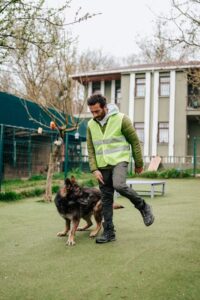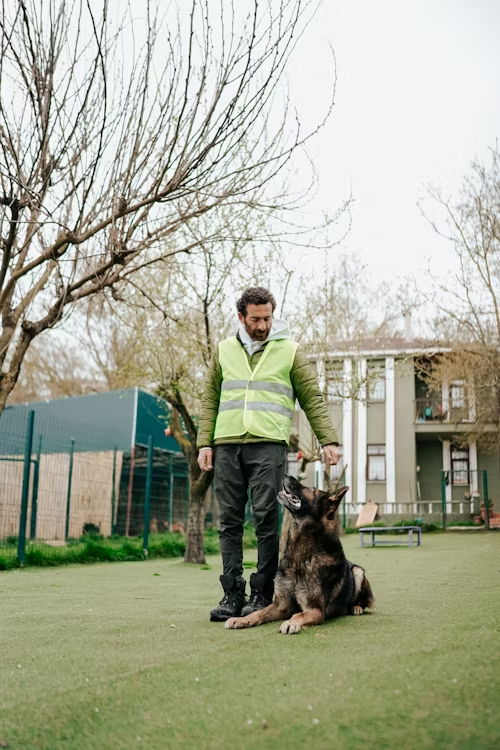One Word Can Change Everything
In dog training, communication is everything. And while dogs don’t understand full sentences, they are extremely good at associating single sounds with actions and outcomes.
This is where marker words come in. A marker is a specific word that tells your dog, with perfect timing, “That was it!” or “Try again.” When used consistently, marker words build clarity, speed up learning, and reduce confusion during training.
In this post, we’ll break down what marker words are, why they’re essential, and how to start using them effectively in your daily training routine.

What Is a Marker Word?
A marker word is a consistent verbal cue that signals a moment in time. It either marks a behavior as correct, indicates a mistake, or releases your dog from a command.
It acts as a bridge between the behavior and the consequence, whether that consequence is a treat, toy, praise, or freedom.
Think of it like taking a snapshot — a marker freezes the moment so your dog knows exactly which behavior earned the result.
Types of Marker Words and What They Mean
1. Reward Marker
Examples: “Yes,” “Good”
Used to signal that the dog performed the correct behavior and a reward is coming. It builds a positive association with doing the right thing.
2. Negative Marker
Examples: “No,” “Uh-uh,” “Wrong”
Used to let the dog know that the behavior was incorrect, but does not involve punishment. It simply means “That’s not it, try again.”
3. Release Marker
Examples: “Break,” “Free,” “Okay”
Signals the end of a command or structured behavior. It tells the dog they’re no longer required to hold the position.
Why Marker Words Improve Training
1. Improve Timing and Clarity
A perfectly timed marker helps the dog understand exactly which action was correct. Without a marker, dogs may get confused about what they were being rewarded for.
2. Reduce Dependency on Treats
When used properly, markers allow you to reward with praise, freedom, or toys — not just food. This builds long-term reliability, even when no treats are present.
3. Speed Up Learning
Dogs love certainty. Clear feedback shortens the learning curve and builds enthusiasm for training.
4. Help Shape Complex Behaviors
Markers can guide your dog through multistep commands, showing them when they’re getting closer to the goal or when they need to adjust.
How to Introduce Marker Words
Step 1: Pair the Word with a Reward
Start with a simple exercise like sit. The moment your dog sits, say your marker word (“yes”) and immediately follow with a treat or praise.
Repeat this until the dog begins to understand that the word itself predicts something good.
Step 2: Use It to Capture Good Behavior
Once your dog understands the word, begin using it throughout the day to mark any desired behavior — eye contact, calmness, going to place, leash pressure releases.
The more consistent you are, the stronger the word becomes.
Step 3: Add a Release Marker
If your dog is in a command like “place” or “down,” you should also teach a release word to avoid confusion. This helps prevent your dog from deciding on their own when the exercise is over.
Say “free” or “break” with a neutral tone, then reward after they move or relax.
Common Mistakes to Avoid
-
Using the word without consistency — weakens its meaning
-
Not following the marker with a reward — breaks the trust in the marker
-
Repeating the word multiple times — turns it into background noise
-
Mixing up marker types — using “yes” as a release or “no” as a punishment
The goal is to use each word precisely and consistently so your dog builds clear associations over time.
How Marker Words Fit Into Real Life
You can use markers to:
-
Confirm a correct sit during a walk
-
Redirect your dog from bad behavior gently
-
Signal the end of crate time
-
Teach impulse control exercises
-
Mark calm behavior around distractions
This creates an ongoing conversation between you and your dog that builds trust, reliability, and faster behavior change.
Final Thoughts: Words That Create Clarity
Marker words may seem simple, but they’re one of the most powerful tools in dog training. When used with clear timing and consistent reinforcement, they transform how your dog understands what you want.
It’s not about saying more. It’s about saying the right word at the right time, over and over — until your dog listens, learns, and responds with confidence.
Transform your dog’s behavior and strengthen your bond—for life.
At Off Leash K9 Training Houston, we understand that no two dogs (or owners) are alike. That’s why our training programs are fully personalized, whether you need help with jumping, leash pulling, anxiety, aggression, or off-leash obedience.
We’ve worked with thousands of dogs and know how to create real change through consistent, proven methods. If you’re ready to enjoy walks without pulling, stress-free visitors, and a dog that comes when called, give us a call at 979-308-3452 today.

